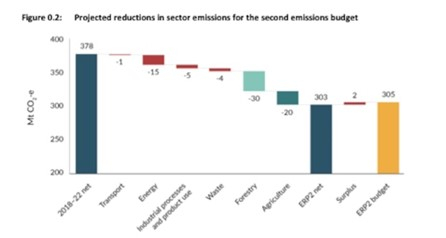Sustainability & Climate Change Update August 2024
Special Counsel
Phone: +64 7 927 0522
Email: rzame@clmlaw.co.nz
Bachelor of Laws, Bachelor of Science, University of Otago
Solicitors
Phone: +64 7 978 2843
Email: tgardiner@clmlaw.co.nz
Bachelor of Laws, Bachelor of Science (Neuroscience), and Bachelor of Arts (Māori Studies).
There’s a lot happening in the Climate Change and Sustainability space - for this mid-year update we provide a selection of topics below:
-
Agriculture to be removed from the Emissions Trading Scheme (ETS)
-
Kapiti Coast struggles with opposition to coastal adaptation measures
-
Climate Adaptation Framework being developed
-
Second Emissions Reduction Plan open for consultation
-
Students for Climate Action unsuccessful in judicial review proceedings against mining decision
-
UK Supreme Court rules local authorities must consider future impact of fossil fuel projects – Finch decision
-
Global Trends in Climate Change Litigation
Agriculture to be removed from NZ Emissions Trading Scheme
In June, the Government confirmed its election promise to remove agriculture from the New Zealand Emissions Trading Scheme (ETS).
On 20th June, the Climate Change Response (Emissions Trading Scheme Agricultural Obligations) Amendment Bill was introduced and referred to the Primary Production Select Committee under urgency. Submissions closed on 28th July and the Select Committee is due to report back on 1 November.
Simply put, the Bill seeks to remove agricultural emissions from the ETS (including removing the current reporting requirements for animal processors). However, as pointed out in the documents accompanying the Bill, the case for legislative change to prevent current NZ ETS obligations at the processor-level from taking effect has been based on the fundamental assumption that an alternative, farm-level pricing system would be introduced no later than 2030.
An alternative pricing system has yet to be developed outside of the ETS. The Government has also announced it will disestablish He Waka Eke Noa, the working group established by the previous government which included industry providers, Māori, and the Government. You can read more about He Waka Eke Noa and the previous government’s response on agricultural emissions pricing here:
https://www.cooneyleesmorgan.co.nz/pricing-agricultural-emissions-government-proposal
In He Waka Eke Noa’s place, a new Pastoral Sector Group will be formed to address biogenic methane. The terms of reference for this group will be developed in consultation with organisations, including DairyNZ, Beef + Lamb New Zealand, Deer Industry New Zealand, Federated Farmers, the Dairy Companies Association of New Zealand, and the Meat Industry Association.
We will continue to monitor the progress of the bill, and the new Group, and keep you updated.
Kāpiti Coast struggles with opposition to coastal adaptation
A newly published report on climate change risks in Kāpiti has recommended the creation of an adaptation plan to address the district's climate-related challenges. The Takutai Kāpiti report (the Report), commissioned in 2021, follows a controversial 2012 initiative by the Kāpiti Coast District Council (KCDC) to add erosion warnings to Land Information Memoranda (LIMs) for properties. This move faced legal challenges from residents who argued the estimates of sea level rise and coastal erosion were exaggerated. Initially, the courts sided with the council, but an independent panel later found the scientific basis insufficient, leading to the removal of these warnings from LIMs. As noted in our earlier updates, as a result of changes to the legislation, natural hazard information will now be required to be entered on LIMs from 1 July 2025.
The Report proposes "dynamic adaptive pathways" for areas along the Kāpiti Coast. These pathways include maintaining current conditions, using soft engineering solutions, constructing hard engineering structures, and retreating from high-risk areas. The report also recommends developing a Kāpiti Coastal Adaptation Plan, ensuring continuous community consultation, and reviewing the pathways every 10 years. It advises against new developments in high-risk areas and suggests planning for strategic retreat when necessary.
However, the KCDC is facing strong opposition from residents and climate change sceptics. Critics argue the plan relies on "extreme and implausible" climate modelling which projects significantly elevated sea levels. Concerns have been raised about the exclusion of protective measures like sea walls and natural barriers and the unique geological features of Kāpiti’s coastline being overlooked.
The financial burden of the Coastal Adaptation Areas (CAAs) process is another major point of contention, with costs to date reaching $4 million and the potential for more if a managed retreat approach is implemented. Residents fear that adopting the CAAs could devalue properties, increase insurance costs, and make it difficult to sell or refinance homes.
The Report was handed to Council for consideration on 20 June 2024. A group of protesters gathered outside KCDC buildings during the report handover to express their opposition to the Report and KCDC’s actions.
Climate Adaptation Framework being developed
Work is now underway at a Government level on a new climate adaptation framework to enhance the country's preparedness for climate change and to better manage increasingly frequent and intense natural events, such as floods and storms.
The framework aims to outline the Government’s approach to sharing the costs of adapting to climate change. It will help communities and businesses understand the planned investments in their areas, such as the construction of flood protection infrastructure, and the support available for recovery from events like slips or floods. Specifically, the framework will explore pathways to:
- Minimize the costs of adapting to climate change-related natural events.
- Create certainty for homeowners and ensure that post-event support is predictable and fair.
- Enable people to make informed decisions to reduce risk where possible.
- Maintain efficient housing and insurance markets.
To support the development of policy advice for the framework, the Government has established an independent reference group. This advisory group is made up of representatives from Treaty partners, local government, banks and insurers and will test policy ideas and explore challenges faced by key stakeholders under the current system.
Legislation to support the framework is expected to be introduced in early 2025. More information on this can be found here.
In addition, the Finance and Expenditure Committee is due to report back on the Inquiry into Climate Adaptation in early September 2024. We will keep you updated.
Second Emissions Reduction Plan out for consultation until 21 August
The Second Emissions Reduction Plan (ERP) (covering the emissions budget for the years 2026-2030) is out for consultation until 21 August 2024.
The ERP sets out how New Zealand will reduce emissions in order to meet the emissions budget and covers all sectors of the economy including transport, energy, building and construction, waste, agriculture and forestry.
You can read our earlier article about New Zealand’s First ERP here:
https://www.cooneyleesmorgan.co.nz/journey_to_net_zero_heating_up_Part_1
A short summary of the discussion document and the full document relating to NZ’s Second ERP can be found here:
The discussion document highlights that emissions pricing, and the ETS, will play a central role in the government’s emissions reduction strategy. It also outlines what the government considers to be its seven key policies being:
- Increasing renewable energy by reducing the consenting burden
- Targeting 10,000 public EV chargers by 2030
- Lowering agricultural emissions by giving farmers the tools to reduce emissions and through fair and sustainable pricing of on-farm agricultural emissions by 2030
- Investing in resource recovery through the Waste Minimisation Fund
- Improving organise waste and landfill gas capture
- Improving public transport
- Investigating carbon capture, utilisation and storage.
More detail on each of these policies and their contribution can be found in Table 0.1 of the Second ERP.
Figure 0.2 of the Second ERP sets out in graphic form where the government considers reductions will come from:
As widely reported in the media, the Second ERP takes a different approach to the previous government with a number of key policies, including subsidising electric vehicles and incentivising heavy industry to decarbonise, already being scrapped. What is clear from the second ERP is that this government considers forestry will form a key role in carbon removal and support for its ‘net based approach’, which purports to use both emission reductions and removals to reduce overall emissions at least cost.
The Second ERP sets out the Sector Plans for Energy, Transport, Agriculture, Forestry and Wood Processing, Non-forestry removals and Waste.
If you’d like more information about the draft Second ERP, or help making a submission, please feel free to get in touch.
Students for Climate Solutions unsuccessful in judicial review proceedings against mining decision
In May, the Court of Appeal released its decision on Students for Climate Solutions v Minister of Energy and Resources [2024] NZCA 52.
Students for Climate Solutions (SCS) applied for judicial review of the Minister of Energy and Resources' decision to grant petroleum exploration permits to Greymouth Turangi Limited and Riverside Energy Limited in Taranaki. SCS asserted that the decision-maker failed to appropriately consider the impacts of petroleum exploration on climate change when granting the permits. The issues were:
- Whether the climate change implications of granting the permits were a mandatory relevant consideration; and
- Whether the decision-maker failed to have proper regard to the principles of the Treaty of Waitangi by failing to consider climate change implications.
The Court held that the climate change implications of granting the permits were not a mandatory relevant consideration. The majority acknowledged the seriousness of climate change but could not interpret the legislation in a manner inconsistent with Parliament’s intention.
The purpose of the Crown Minerals Act is “to promote prospecting for, exploration for, and mining of Crown-owned minerals for the benefit of New Zealand.” The Court interpreted this to mean economic benefit to New Zealand, which does not require decision-makers to balance this against the climate impacts of fossil fuels. The Court noted that the Act was reviewed in 2018 and 2023 without any amendments to reflect the appellant’s interpretation. The Court stated, “the fact Parliament considered the Crown Minerals Act in the specific context of climate change and nevertheless left the wording of that section unchanged also leaves no room for the ambulatory approach to statutory interpretation.”
The Court also held that the decision-maker did not fail to have proper regard to the principles of the Treaty of Waitangi. Although the Crown Minerals Act requires the decision-maker to consider these principles, the Court found that the decision-maker had consulted with affected iwi and responded to their concerns appropriately.
The Court noted that the affected iwi did not raise climate change issues. Furthermore, the Court stated that the decision-maker was not required to conduct a wide-ranging inquiry into the potential climate impacts on Māori, and thus, the decision-maker did not violate the Crown's Treaty duty of active protection. The appeal was dismissed. The full decision can be found here.
UK Supreme Court rules local authorities must consider future impact of fossil fuel projects – Finch decision
Meanwhile, the UK Supreme Court has ruled that local authorities must consider the future impact of proposed fossil fuel projects, including downstream greenhouse gas emissions, when deciding whether to grant consent for development projects.
In a landmark case[1], a developer sought permission from Surrey County Council to expand oil production at one of their sites. The developer argued that the Environmental Impact Assessment (EIA), required under UK planning regulations, should only assess direct greenhouse gas emissions within the well site during the project's lifespan. They contended that emissions from burning the extracted oil elsewhere should not be included.
A local resident challenged the Council’s decision to grant consent, arguing that the EIA should include these emissions. The High Court upheld the Council's decision, stating that combustion emissions were not legally required to be considered in the EIA. This stance was later supported by the Court of Appeal.
However, the Supreme Court, by a narrow majority, ruled that the Council's decision was unlawful for not including combustion emissions in the EIA. The majority judgment held that since the oil would inevitably be burned, producing significant greenhouse gas emissions, these emissions are indirect effects of the project and must be assessed in the EIA. The Court emphasized that the EIA Directive does not limit environmental effects to the project's location and rejected the view that refining oil breaks the causal link to combustion. Consequently, the Supreme Court concluded that failing to assess combustion emissions rendered the planning permission invalid.
We are already starting to see the Finch decision being cited in legal proceedings in New Zealand, although we are yet to receive any comments from the New Zealand courts on the impact of this decision. In particular, the Supreme Court in the Otakiri Springs water bottling case has requested legal submissions on the relevance of the Finch decision.
Global Trends in climate change litigation
The Grantham Institute has recently released its annual report on developments in global climate change litigation. The latest report can be found here:
The Report focuses on the 2023 calendar year and some of the key insights from the report are summarised below:
- The rate of increase in climate cases has slowed, but these cases have spread to more countries. In 2023, new cases were filed in Panama and Portugal for the first time.
- 2023 saw an increase in international climate change litigation, with major international courts and tribunals being asked to rule and advise on climate change. These type of cases have significant potential to influence domestic proceedings.
- Significant successes were noted in ‘government framework’ cases in 2023, where cases seek to challenge the ambition or implementation of a government’s overall climate policy response.
- One notable case was KlimaSeniorinnen and ors. v. Switzerland where the European Court of Human Rights confirmed that government inaction on climate change violates the European Convention on Human Rights; with the report noting this decision is likely to lead to the filing of further cases.
- Corporate climate litigation continues, with 47 "climate-washing" cases identified last year, over 70% of which favoured the claimants. More than 30 cases have sought to hold companies accountable for climate-related harm caused by greenhouse gas emissions. The report highlights a new category, "transitional risk" cases, targeting corporate directors for mismanaging climate risks.
- Nearly 50 cases were labelled as "not aligned with climate goals," where courts were used to delay or derail climate action. The report notes a rise in "ESG backlash" cases, such as Wong v. New York City Employees’ Retirement System, where plaintiffs claimed fund managers breached fiduciary duties by incorporating climate considerations into investment decisions.
-
Strategic climate cases continued to be filed against companies, with about 230 such cases now identified from 2015 to the present. Key trends in corporate climate litigation include:
- The number of cases concerning ‘climate-washing’ has grown in recent years.
- There were important developments in ‘polluter pays’ cases: more than 30 cases worldwide are currently seeking to hold companies accountable for climate-related harm allegedly caused by their contributions to greenhouse gas emissions.
- Litigants continue to file new ‘corporate framework’ cases, which seek to ensure companies align their group-level policies and governance processes with climate goals. The New Zealand Supreme Court allowed one such case to proceed to trial (Smith v Fonterra), although cases filed elsewhere have been dismissed. The landmark (Dutch) case of Milieudefensie v. Shell is under appeal.
- In this year’s analysis a new category of ‘transition risk’ cases was introduced, which includes cases filed against corporate directors and officers for their management of climate risks. Shareholders of Enea approved a decision to bring such a case against former directors for planned investments in a new coal power plant in Poland.
If you have any question, please contact Rachael Zame, Special Counsel, or another member of our Climate Change and Sustainability Team.
Special thanks to Solicitor, Te Hau Ariki Gardiner-Toi, for his assistance with this update.
[1] R (on the application of Finch on behalf of the Weald Action Group) v Surrey County Council and Others [2024] UKSC 20







